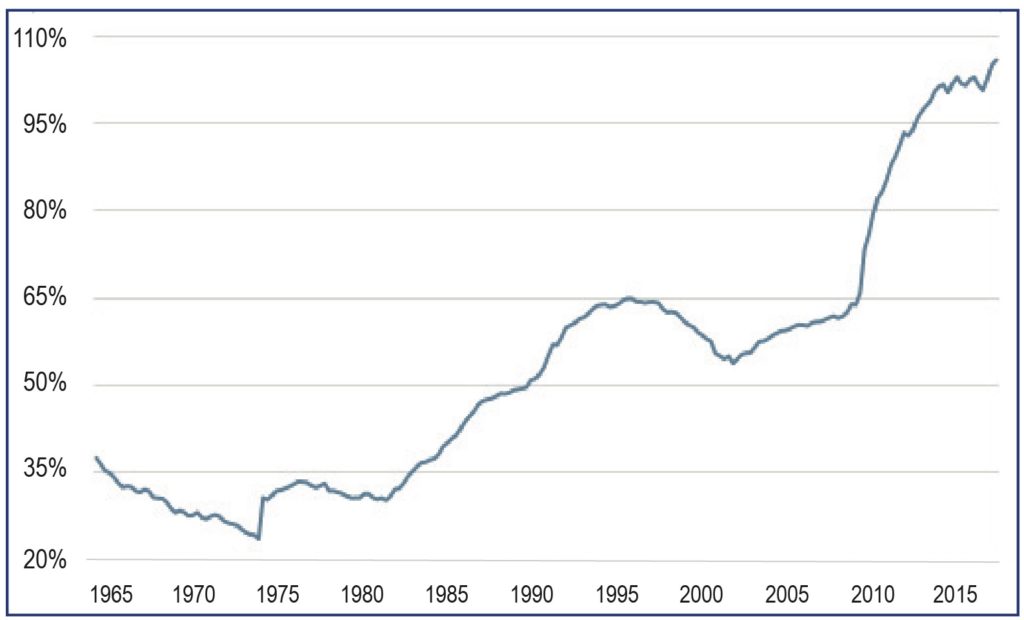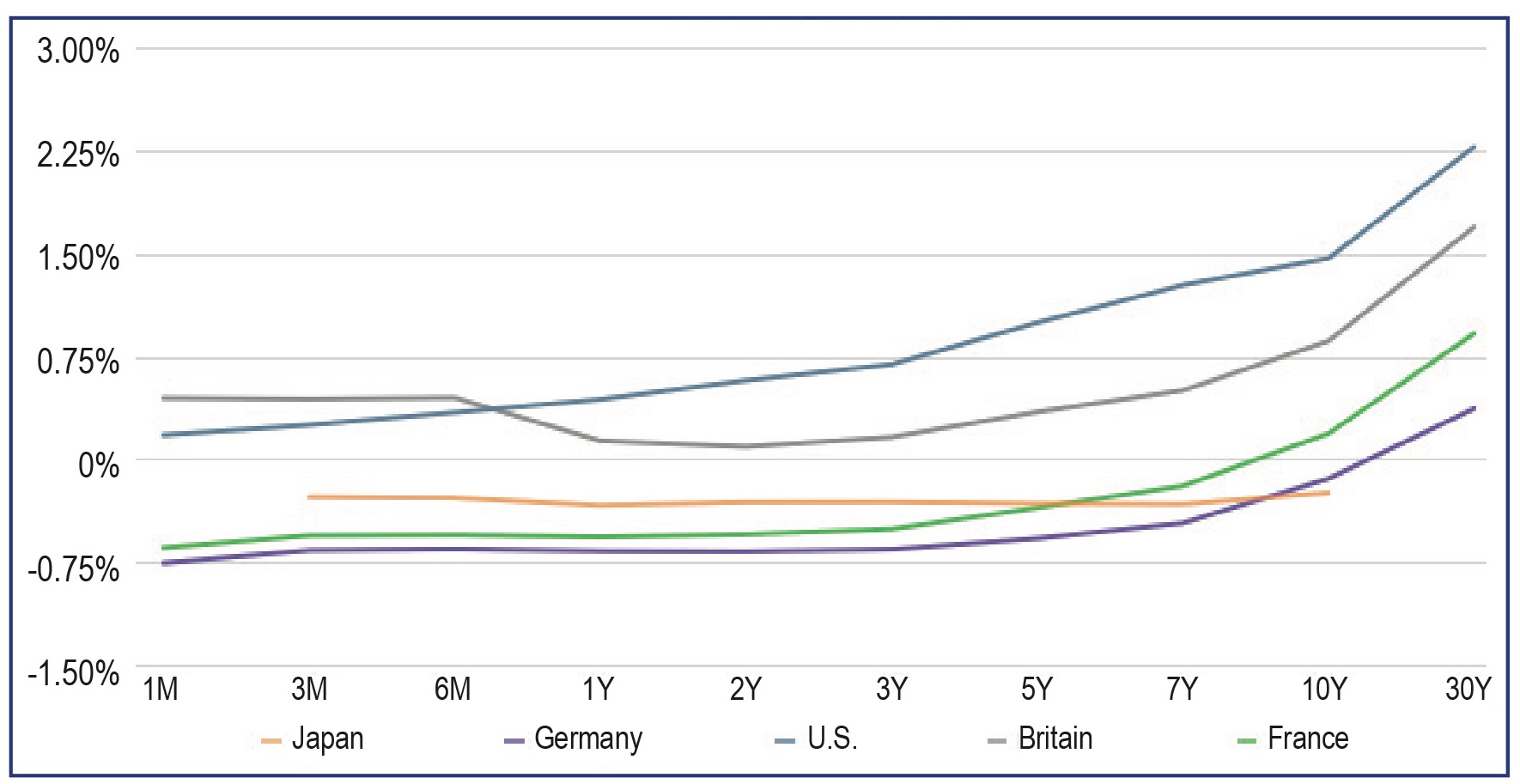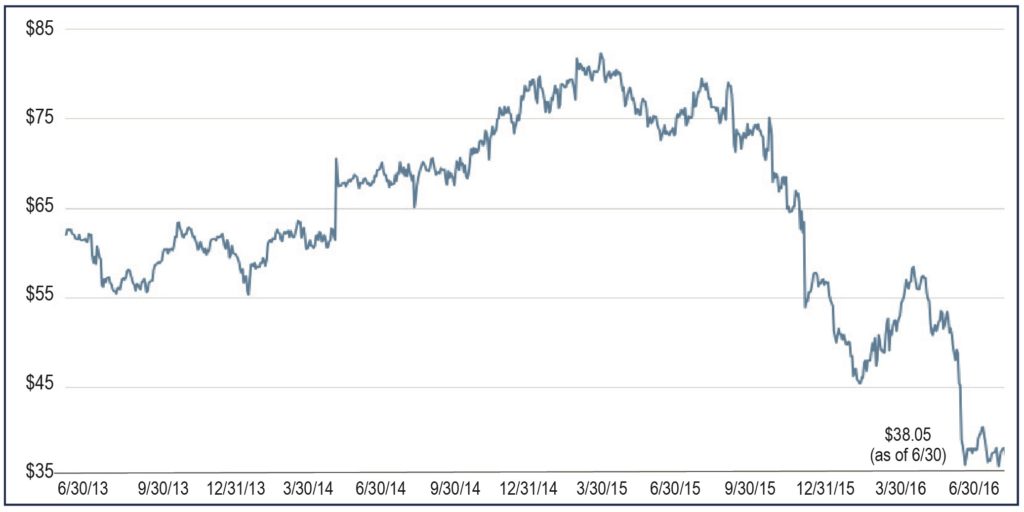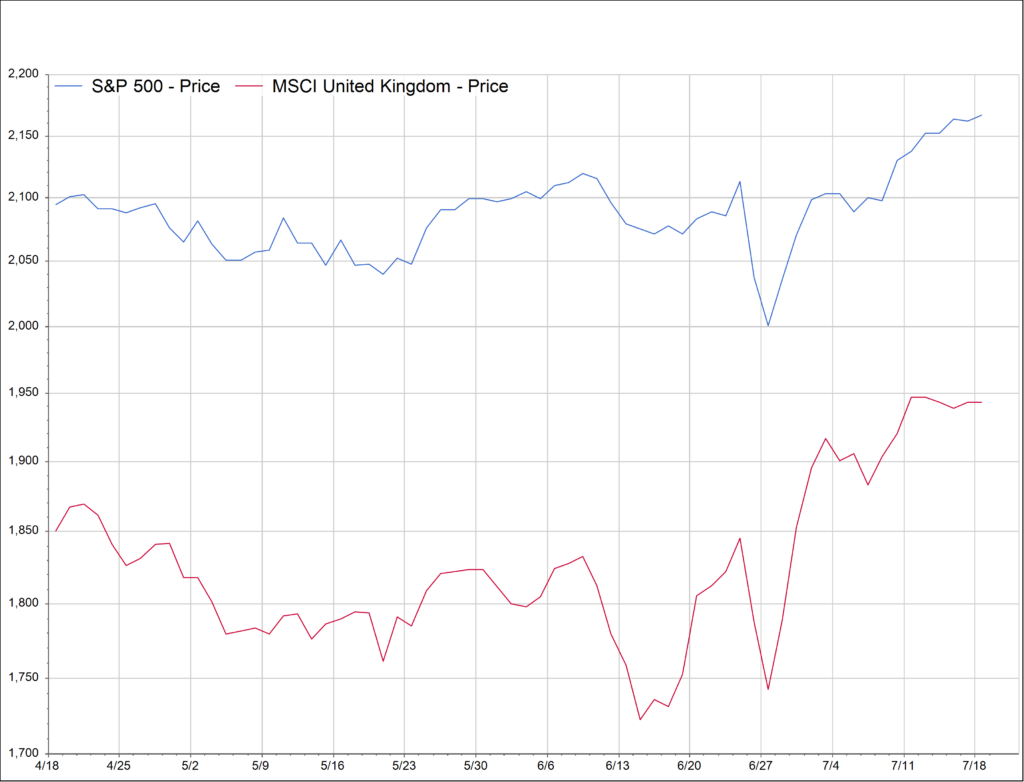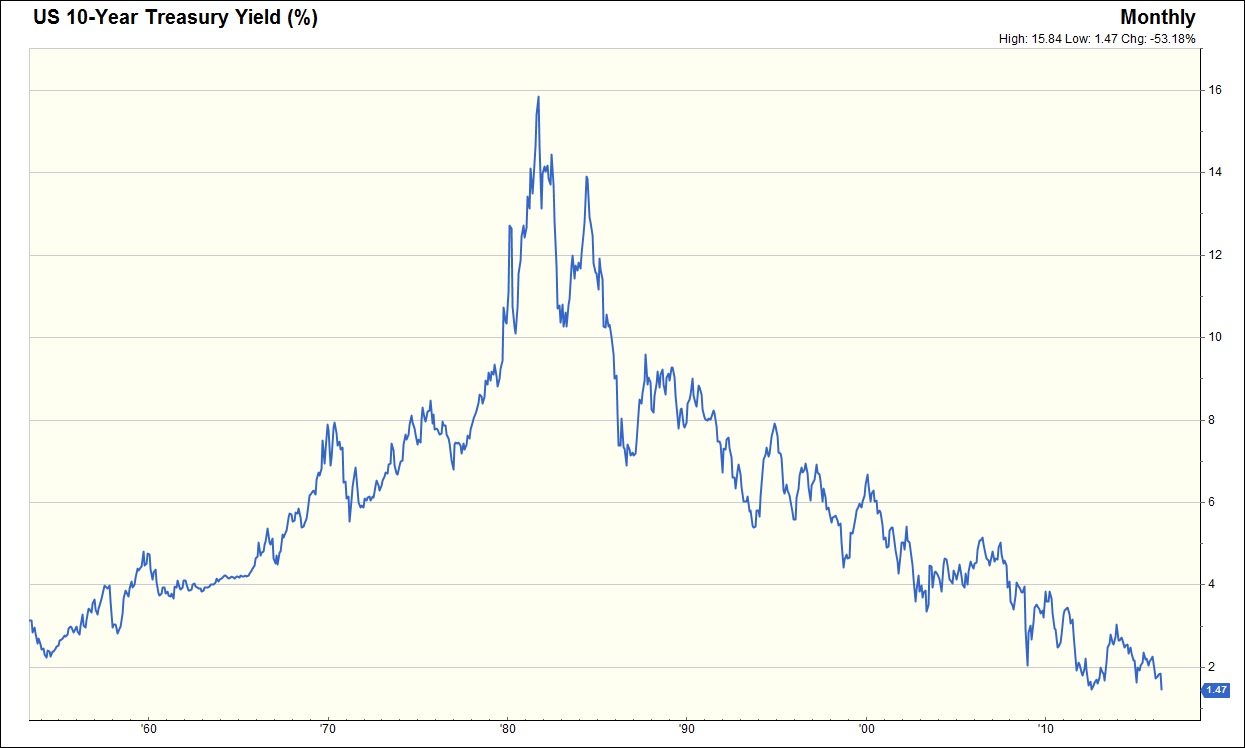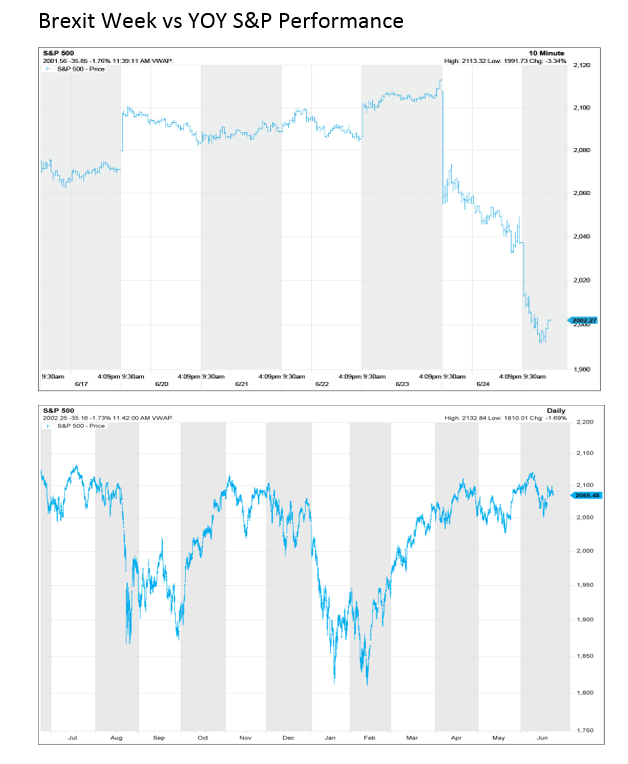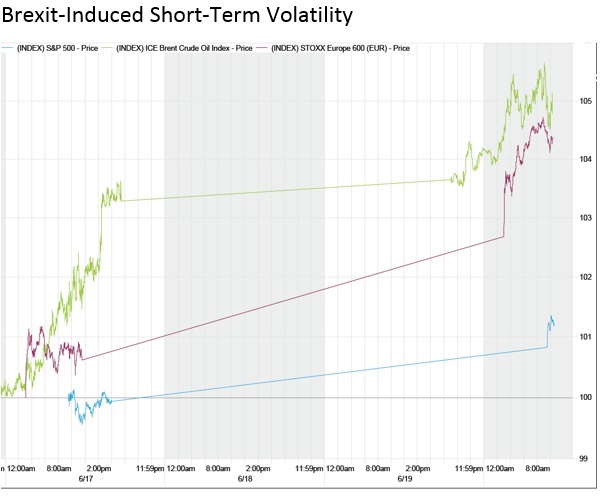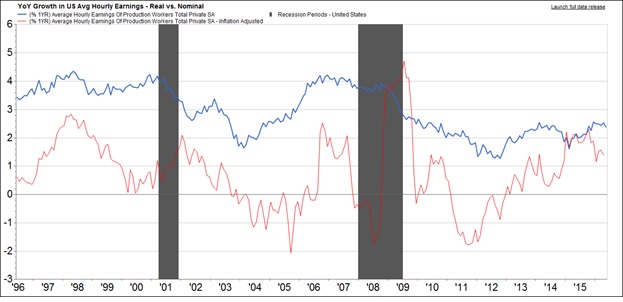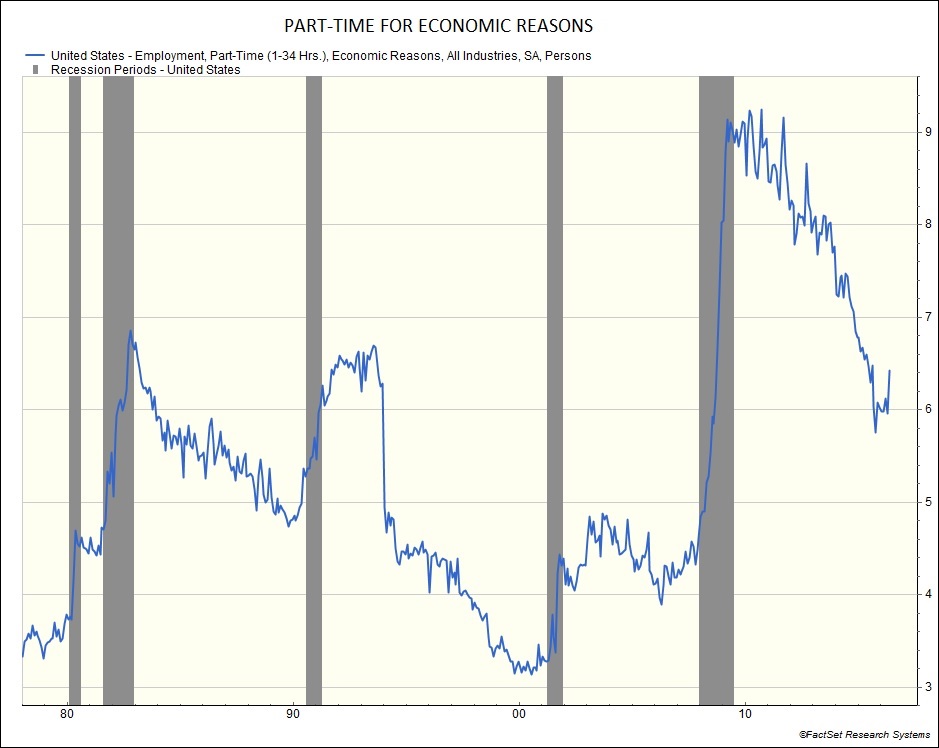What’s On Our Minds:
The International Monetary Fund (IMF) announced last week a cut to its global growth estimate; the Fund cut this year’s estimate by 0.1%, bringing the estimated figure to 3.1%. Not surprisingly, the decision to cut growth approximations was Brexit-induced, but the IMF also cited other factors—growing political instability, nationalism, and terrorism to name a few—as chief reasons for the decrease, stating that these issues could even further stymie growth. Shocking.
In a message targeted at G-20 nations, the IMF stressed that continued lackluster growth should incentivize nations to keep access to cash “cheap”, utilizing all fiscal and monetary policies at their disposal. This requested targeted our home front—the IMF stated that while the United States economy is set to take off on a (much needed) upward trajectory, the Fed needs to be cautious with rate-hikes (an evaluation intended to spur-off the potential for a September rate increase), citing the negative effects of a stronger dollar amidst global disinflationary and deflationary struggles.
Year-Over-Year CPI Inflation Trends of Major Economies 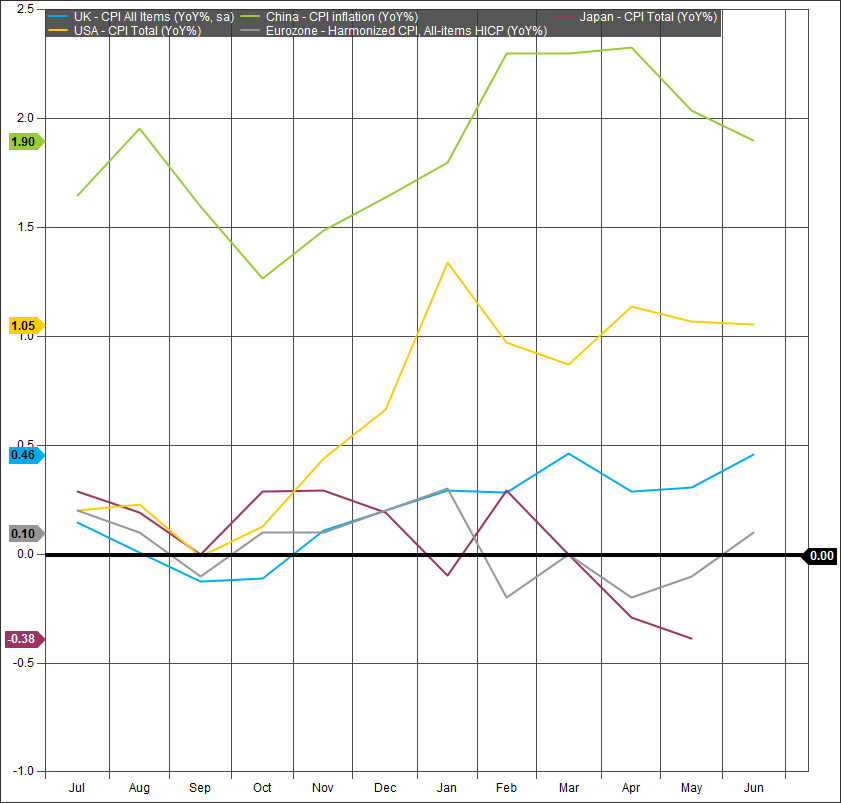
Global periods of slow growth—or as the academics of the world dub it: “secular stagnation”— plus the implications of Brexit place relatively strong economies, like the United States, between a rock and a hard place: increase rates and be the cause of a potential macro mess, or move along with trepidation hoping that European turmoil does not burst and put us deeper in the rut from which we are (slowly) climbing out. Now those are some choices!
Like those before them, these IMF revisions have not changed the strict and conscientious approach taken by Tufton’s research and investment teams. We continue in remaining anchored to our disciplined long-run approach to investments.
Last Week’s Highlights:
Equity markets were up, continuing a four week winning streak. The Dow Jones added 0.3% while the S&P 500 and Nasdaq both rose 0.5%. Companies reported strong second quarter earnings numbers which helped propel indexes higher. Boston Beer (SAM), the maker of Samuel Adams beer, posted big results and its stock gained 15% on the news. Burrito chain, Chipotle, has had a rough year so far but posted strong results last week which send its stock up 6%. Nintendo shares have skyrocketed since the release of the Pokemon Go game earlier this month, but the company has warned that the impact the game will have on the company will be “limited”.
Looking Ahead:
Earnings season gets exciting this week with some headline grabbers reporting. Under Armour reports earnings Tuesday morning. Apple reports after the closing bell on Tuesday afternoon. Apple has been under performing the market this year and analysts are expecting that iPhone sales declined during the quarter. Facebook is currently trading near all-time highs and will report earnings on Wednesday afternoon. Then on Thursday, Amazon will report results. Alphabet (still referred to as Google by most) also reports on Thursday afternoon. It will be interesting to see if these four big tech companies can pick up their momentum. Ford reports on Thursday. The company has been selling their F-series pickup trucks like hot cakes so far this year but the stock is off 2%.
The toasty temperatures and lengthy days of June, July and August have long been called the Dog Days of Summer. While the summer months usually mark a slow period for Wall Street and the financial markets, the business newswires have been anything but quiet.
Between political concerns at home and volatility abroad, the market continues to keep investors on their toes. Nowhere was this more apparent than in Britain’s surprise decision to part ways with the European Union, resulting not only in the disappearance of trillions of dollars from global capital markets, but also, and more dangerously, the appearance of nearly as many breathless “Brexit” headlines.
In the late days of this past June, even the most optimistic observer could be forgiven for believing that the sky was falling. And while the market went on to regain the ground it gave up—and then some—the question now looms: with instability potentially lurking in the next news cycle, what should you do?
In a word: you should go on vacation and enjoy the summer months, even if the market refuses to follow suit. In times like these, filled to the brim with short-term uncertainty, we believe that our firm’s careful, disciplined, and emphatically long-term investment outlook is more important than ever—and that, while all investors look at current events, great investors strive to look through them. So whether this letter finds you at your desk or your dock, rest assured: our team here at Tufton Capital remains hard at work on your behalf…Dog Days of Summer be darned!
We begin this edition of Tufton Viewpoint with our firm’s outlook for the economy and financial markets beginning on page two. As you’ll read in our investment analyses throughout Viewpoint, we continue to be cautious but still positive on the equity markets even as we approach new highs for the Dow Jones and S&P 500 indexes. And while we anticipate a slightly positive second half of 2016 for equities, we anticipate another period of volatility in getting there.
Every four years, politics and finance converge as Americans elect a president and investors attempt to forecast how the outcome will affect their portfolios. Our article on page four, “Trump vs. Clinton: Who is Better for the Markets”, concludes that the uncertainty surrounding the outcome may have a larger short-term impact on the financial markets than who ultimately wins.
We hope that you find these and the other articles throughout Tufton Viewpoint interesting and thought- provoking and encourage you to reach out to our financial team to discuss any of these topics in more detail. All of us at Tufton Capital wish you and your families an enjoyable rest of the summer, and we sincerely thank you for your continued support!
Chad Meyer, CFA
President
by Eric Schopf
Fireworks came early this year as the United Kingdom voted in favor of leaving the European Union. The outcome of the nationwide referendum was not what the markets expected, leading to a wild ride in the stock market and tremendous price volatility, both down and up. The outcome of the June 23 vote was not apparent until the following day. The stock market reaction was swift, with the S&P 500 declining 3.6%. After taking the weekend to digest the news, investors extended their selling mood the following Monday, resulting in an additional drop of 1.8%. When the dust settled, the S&P 500 was sitting at levels first reached in the fall of 2014.
Fixed income markets reacted in similar fashion, with the safe-haven 10-year U.S. Treasury note dropping in yield from 1.74% prior to the vote to 1.43% the following Monday. Later in the week, the realization that the immediate economic impact of the U.K.’s departure would not be calamitous had investors rushing back into the market. The final three trading days of the month provided strong gains and led to a recovery of nearly all initial Brexit-related losses. We closed June exactly where we started and are again within 1.5% of the record high set last July. The 10-year U.S. Treasury yield, however, has remained low with a month-end close of 1.47%.
The stock market posted respectable results for the second quarter, with the S&P 500 delivering a total return of 2.5%. Year to date, the total return is 3.8%. The Federal Reserve continues their accommodative stance thanks to an economy that just can’t seem to find the next gear. A weak Bureau of Labor Statistics payrolls report for the month of May combined with steep downward revisions to March and April figures kept the Fed on their back foot and appears to have eliminated any possibility of an interest rate hike in the near term. Interest rates quickly reflected the Fed’s new dovish outlook. As a reminder, the 10-year U.S. Treasury started the year at 2.3%.
Volatility in reaction to the future of the European Union will likely persist. The United Kingdom’s exit negotiations with the EU will stretch out a number of years and there is no telling the composition of the final agreement. Trading relationships, potential tariffs, and investment flows are all now in question. Consumer and business confidence will suffer until there is some clarity on these important issues. It is also difficult to project the future standing of the remaining EU members. Immigration curbs in England will place additional pressures on member countries to accommodate refugees. In addition, should the U.K. somehow manage to flourish under their EU independence, more members may defect.
General US Government Debt as a % of GDP
The United Kingdom’s exit will not greatly impact the global economy, as the sovereign state represents less than 4% of the global gross domestic product. The EU, on the other hand, collectively represents 23% of global gross domestic product. The general health of the EU is a bigger concern than the decision by the U.K. to exit. This we do know: the U.K.’s vote to leave the EU will result in a lower standard of living vis-a-vis a lower relative currency valuation. The Pound/Euro conversion shot from .76 to .83. Prior to the vote it took .76 Pounds to buy 1 Euro. The same Euro now requires .83 pounds. That trip through the Chunnel into France will now be 9% more expensive. The same is true for conversion to the U.S. Dollar. .75 Pounds are now required for 1 U.S. Dollar, up from .67 Pounds. A trip to New York is now 12% more expensive.
Back home, the Federal Reserve continues to greatly influence the fixed income and equity markets. The steady drumbeat of bad news from around the world has the Fed looking beyond the U.S. economy when making interest rate decisions. Brexit and its potential to disrupt economic activity in the short term are just the latest obstacles. Slow growth in China and Japan, uneven growth throughout the Eurozone, and sickly economies in South America have central bankers working overtime implementing monetary policy. The European Central Bank expanded their asset purchase plan in June to include corporate bonds. The massive bond purchases have pushed interest rates into negative territory throughout Europe. That’s right – bond holders, instead of receiving interest payments, are actually paying creditors for the privilege of holding their debt. The Fed is in no position to increase interest rates in the current global environment. The beneficiary of current monetary policy has been shareholders. Equities become more attractive as interest rates fall. The most disconcerting aspect of the whole exercise is the fact that economic growth has been so anemic despite the extraordinary monetary efforts.
It appears that there may be limits to the effectiveness of monetary policy. The Federal Reserve has noted on numerous occasions that fiscal policy plays an equally important role in influencing the economy. The government’s tax and spend policies, however, have been capped due to government debt reaching its permissible levels relative to the size of our economy. It was just five years ago when sequestration reentered our financial lexicon. The automatic budget cuts were a way of reducing the federal budget without being directly tied to the legislature. Unless the new administration is willing to alter fiscal policy to generate more growth, we may continue to be stuck in our current low interest rate environment.
The investment environment continues to be challenging. Corporate profit growth has slowed, and interest rates remain low. The upcoming presidential election promises to keep investors on edge. Regardless of the environment, we continue working hard to find attractive investments worthy of your portfolio while maintaining suitable balance to reduce risk.
Global Yield Curves
by John Kernan
There are many hotly debated topics concerning the presidential candidates. One that people come to us about time and again is, “Who would be better for the markets?”
Markets hate uncertainty. Even uncertainty about two outcomes that are mostly neutral can push markets lower. While Trump supporters may believe that his pro-defense, conservative stance might provide more stability, Clinton supporters fire back with the fact that Trump is an unknown quantity and brings uncertainty. Clinton would be a known quantity, for good or for ill, and is often viewed as an extension of the current administration.
It is tempting to look to historical averages to get a better idea of what result would have the best effect on the market. Indeed, we found plenty of articles online that do just that. However, some very basic statistical analysis- just looking at the numbers- shows us we can’t rely on those averages. There are simply far too few elections for any average to make sense.
To analyze the effects on the market, we need to look at elections where no incumbent was running, of which there have been only eight in the last century. One of those, in 1928, had a 49% gain- which had more to do with speculative trading and the roaring 20’s than the election of Herbert Hoover. Similarly, it was the housing crash and financial crisis, not the election of Barack Obama, that led to a 31% loss in 2008. So, we look elsewhere.
Trump’s plan for a wall and increased immigration policing can be partially offset by decreased military spending. His plans are to support larger, more powerful armed forces with less money. However, his proposal to institute big tax cuts that are revenue neutral are under intense scrutiny (and sometimes ridiculed) by professionals. The Committee for a Responsible Federal Budget (CRFB) estimates Trump’s plan will reduce federal revenues by $10.5 trillion in the first decade, and increase debt by $11.5 trillion. Trump counters that his plan would generate enough growth that it would more than pay for all of the spending. The CRFB disagrees.
Clinton also looks to increase spending, but would increase debt by $250 billion, close to where it would be without any changes at all to the current plan. The difference is a tax increase on high earners and businesses. Without the promises of large tax reductions, her budget plans look much easier to realize.
There simply is not enough to go on here to justify a change in investment policy. Whether Clinton means lower growth, or Trump means higher borrowing costs, or vice versa, anything that is knowable is already priced in to the market. While some investors might believe they have a special understanding of the international debt markets, for example, and can earn a premium over the next several months, that is not how we believe most people should be investing.
We find it very unlikely that either candidate will by themselves cause the financial markets to change their patterns of risk and return. We continue to watch individual stocks for their exposure to tax plans that may affect their business—aerospace companies like Lockheed Martin, for example. But no election result would likely cause us to reallocate money out of, or into, different asset classes. Furthermore, because indexes like the S&P 500 are market capitalization weighted, as the price of a stock increases, the stock receives a greater weighting in the index. This conflicts with what we focus on as value investors – buying securities as they fall in price.
by Scott Murphy
It is a well-known fact that Nordstrom (Ticker: JWN) is the retailer with the greatest return policy in the industry: if you are not happy with your purchase, return it for a no-questions-asked refund. This laser focus on the customer experience is what separates Nordstrom from its competitors and inspires the customer loyalty that is the envy of the retailing world. With its headquarters in Seattle, Washington, it is currently operating 315 stores in the U.S. and Canada. These include 121 full-line stores and 194 Nordstrom Racks located in 38 states with good prospects for store growth in underserved regions of the country.
The stock price has fallen 20% year to date due to a significant reduction in its sales forecast and expected earnings per share for 2016. Nordstrom certainly isn’t alone in this consumer-led stock selloff, and of those in its industry that have sold off, Nordstrom retains a leading position. Management is pulling back store openings and will cut its corporate staff by 10% in order to better position the company for rosier times. As value-oriented investors, we will continue to monitor this investment and stay patient. We believe our original thesis is still intact, and more time is needed for the underlying business of this great company to recover.
We still feel Nordstrom is a solid company and will trade higher as the industry conditions improve. The company has a strong balance sheet, is selling at five-year lows using Price/Earnings and Price/Cash Flow metrics and has a generous 4% dividend yield. Sometimes it takes patience for a great company to work out to be a great investment. Brick and mortar retailers are not “in fashion” right now on Wall Street, but we believe that fact means a good value for our clients.
Nordstrom (JWN) Price Performance
by Rick Rubin
At Tufton Capital, we allocate portfolios based on our clients’ financial objectives, risk tolerance and time horizon, and we factor in our expectations for long-term investment returns. For most clients, we manage balanced accounts that consist of diversified portfolios of stocks, bonds and cash. Occasionally, a client asks us whether all their investments should be fully invested in stocks, because stocks have higher returns over time. Our answer is usually … NO! A key reason to diversify your assets is related to a concept known as “correlation.”
How do we apply this concept to managing money? Correlation quantifies the strength of the association between two variables. Correlation is expressed as a value between -1 and 1, with 1 indicating perfect positive correlation and -1 indicating perfect negative correlation. Our ultimate goal is to identify a portfolio of securities with high return expectations and with high negative correlation to each other (-1 or slightly under). Said differently, we want to own securities that perform well in the long run and whose price changes do not track each other closely.
For example, we invest in stocks across a wide range of economic industries such as technology companies, utilities, financials, etc. We like the long-term value characteristics of many technology companies (Microsoft, Oracle, Qualcomm), and yet we continue to have sizable investments in slower-growth utility and telecommunications sectors. In part, we can justify these seemingly differing investment positions because of the “correlation” benefits. That is, the technology sector’s stock prices behave quite differently than stocks in the other two sectors in the short term.
As compared to stocks, we view bonds and cash as “defensive” investments. Typically, bonds we purchase tend to perform well when the stock market is weak. In particular, U.S. Treasury bonds are viewed as a safe haven by investors, and these bond prices rise sharply during times of stock market turmoil (think 2008-2009 financial crisis). Thus, we invest a portion of our clients’ money in U.S. Treasuries because these bonds have high negative correlation to the stock market.
We use stocks as the primary vehicle of producing capital appreciation, income and dividend growth for clients. Stocks prices are volatile, and they can add stress to investors’ lives as they watch their investments fluctuate. As your portfolio manager, we work to lower your portfolios’ volatility by using a balanced allocation and purchasing value-oriented stocks that offer a margin of safety. It’s important to remember that even though stocks can be volatile in the short term, historically, stock returns far exceed the returns of bonds and cash. Also, stocks protect a portfolio’s purchasing power against the negative impacts of inflation.
We believe above-average dividend yields of high-quality companies provide huge benefits to a portfolio. One of the biggest advantages of reinvesting dividends is a compounding wealth effect. Albert Einstein realized this concept when he said “compound interest is the eighth wonder of the world. He who understands it, earns it … He who doesn’t … pays it.” Although slowly compounding dividends may not be as exciting as your friend’s hot stock tip, this strategy helps build and preserve your wealth over time. We believe in owning shares of well established companies that consistently pay and grow their dividends!
Learn how to use charitable giving tools to grow a donation through investment, possibly allowing you to donate more than by gifting directly.
When making a sizable donation as a direct gift, you know exactly how much you can afford to give and how it will affect your overall finances, but you may wish you could do more. If so, charitable trusts and annuities provide ways for you to make a major charitable donation while simultaneously receiving reimbursements that can help provide financial security.
Charitable Gift Annuities (CGAs)
With a normal annuity, donors fund the annuity with an initial payment, this payment receives gains from investment and then the donor is paid a fixed income throughout the year using this money. With a CGA, the charity, rather than an investment firm, serves as the management company, and any profits the investment earns go to the charity rather than the donor.
Essentially, CGAs allow a charity to borrow the money put into the annuity for investment growth before returning the majority of it back to the holder through annuity payments. CGAs usually have lower return rates than other annuities, but can compensate for these low returns through the tax benefits that they offer. The charitable donation deduction amount is equal to the present value of the charity’s “remainder interest” of the donation, or the excess of the fair market value of the donation over the present value of the annuity. This allows the donor to receive an income tax deduction as well as a portion of the donation back through annuity payments.
As with any investment, CGAs do have some downsides. They can tie up a large portion of your retirement funds and are costly to terminate outside of their set term. Before you enter into a CGA, you should be completely sure that you will not need the funds you are contributing in the immediate future. CGAs can also be risky because they will terminate if the charity you donate to goes bankrupt. In order to avoid this, it’s crucial to research the charity you will donate to and make sure that it is financially stable.
Charitable Remainder Trusts (CRTs)
CRTs provide a different way to grow charitable donations through investment. The donor makes an initial donation to the trust, which is then invested and makes annual distributions to a beneficiary (usually the grantor), giving the remainder to the chosen charity. CRTs offer more security than CGAs because they don’t make the donation until the end of their term, so donors can give to smaller and potentially less stable charities without putting their income at risk.
CRTs offer many tax benefits, including an income tax deduction and the fact that the trust itself is not taxed for income. However, the beneficiary is taxed on any income distributed to him or her.
Many people nearing or at retirement age choose to donate through a CRT because it can provide them with an annuity for a number of years. For those donors who have estate planning concerns, CRTs may be especially attractive, as they offer a full estate tax deduction if created at the grantor’s death. When considering CRTs, grantors should keep in mind that they are required to distribute between 5 and 50 percent annually to the beneficiary of the trust.
Charitable Lead Trusts (CLTs)
CLTs are similar to CRTs, except that they make their annual distributions to the charity and hold the remainder for the grantor or beneficiary instead of the other way around. If the grantor receives the remainder, it is referred to as a “grantor trust,” while if a beneficiary or third party receives the remainder, it is referred to as a “non-grantor trust.”
Grantor trusts offer an income tax deduction, while non-grantor trusts provide an estate tax deduction. Additionally, with a grantor trust, the grantor is taxed for income not given to the charity. With a non-grantor trust, the trust itself is taxed for this income. Grantor trusts are usually used if an individual wants to donate during his or her lifetime, while non-grantor trusts are used to provide a gift to an individual’s family after his or her death while still providing money to charity.
Annuities versus Unitrusts
CRTs and CLTs both come in two different forms, annuity and unitrust. The only difference between the two is how annual payments are calculated. With CRATs (charitable remainder annuity trusts) and CLATs (charitable lead annuity trusts), the beneficiary receives annual payments of fixed dollar amounts. With CRUTs (charitable remainder unitrusts) and CLUTs (charitable lead unitrusts), the beneficiary receives annual payments at a fixed percentage of the trust’s value for that year. CRATs and CLATs offer more consistency, while CRUTs and CLATs give the beneficiary the opportunity to potentially receive larger (or smaller) payments depending on the trust’s value that year.
Choosing a Giving Method
Charitable trusts and annuities can allow you to make a larger contribution to charity than a simple gift, because they allow your money to grow over the trust’s term. However, these options can be expensive and difficult to manage. They also create an extended timeline, which delays the full benefit of your donation from reaching the charity until a number of years have passed. Yet, for donors that would otherwise have to sacrifice their charitable goals to protect their own finances, trusts and annuities may be a more appealing option.
Before deciding to integrate these types of giving vehicles into your charitable strategy, interested donors should seek financial and legal advice to avoid any potential complications. n
This article was written by Advicent Solutions, an entity unrelated to Tufton Capital Management. The information contained in this article is not intended for the purposes of avoiding any tax penalties. Tufton Capital Management does not provide tax or legal advice. You are encouraged by your tax advisor or attorney regarding any specific tax issues. Copyright 2013 Advicent Solutions. All rights reserved.
What’s On Our Minds:
Are we done talking about Brexit yet?
The US and worldwide news cycle might lead you to believe that we’re in turmoil, but the markets beg to differ. The gravity of the issues that face our country and our world shouldn’t be downplayed. There are a lot of things going on surrounding Brexit, and investors have come to us with questions. We thought this would be a good place to address some of them.
Is Brexit good or bad?
This is the political question of the day. Economic theory states that free trade is always better for society overall. For example, say that a country can import 1,000,000 TVs for $400 each, or make them at home, where they will cost $425 each. That’s a $25 million savings for the country overall- but that one company that just lost out on $425 million of sales is going to make a lot more of a fuss than a bunch of people who probably don’t even realize why they saved $25 on a TV. The country then has to decide if it’s worth having more expensive products in order to save a few jobs (for each product).
Then, with free trade comes the freedom of movement afforded by the EU. This means that once a person is inside the EU, he or she is free to move between countries without any border controls, much like the movement between states here. It is also an economic fact that an influx of workers willing to accept lower wages will lower the median wage for everyone. Since countries in the EU retain a lot of sovereignty and identity, they don’t think of it as giving jobs to other Europeans; they think of other countries taking their jobs. We in Maryland don’t worry about “no-good Alabamans” taking our jobs, because we think of everyone as part of one country. But in the EU, countries still think of themselves as very separate.
Trying to have a unity between countries in Europe like we did between states after the Civil War is not something that will come quickly, without tension, or without political and cultural change.
What does Brexit mean for the US?
Well, as it turns out, not much. As we discussed last week, markets panicked at first, but then seemed to realize that things here will be good, with or without a united United Kingdom. UK markets, too, recovered (see below).
So why all the fuss?
England is only about 4% of the world’s GDP. But the EU as a whole is larger than the United States. If there is contagion and a breakdown of the ties between EU countries generally, it could spark a worldwide financial and economic crisis perhaps worse than the 2008/9 one here in the US. Needless to say, a big deal. As it stands, though, we don’t think and EU meltdown is in the cards.
Last Week’s Highlights:
For the third week in a row, stocks were up. With last week’s 1.5% gain in the S&P 500, markets have rebounded 8% since the big drop following the Brexit. Since then, U.S. jobs numbers have showed strength, retail sales numbers beat expectations, we have had a good start to earnings season, and foreign governments have committed to stimulating their weak economies abroad. It was a record-breaking week, as for the first time since 1998 the S&P 500 hit intra-day record highs each day. In company news, Germany’s Bayer increased its offer to purchase seed-maker Monsanto to $125 per share. Disney issued corporate bonds with record-low yields. The company issued a 10 year debt with a 1.85% yield and 30 year debt at 3%.
Looking Ahead:
Even with tragedy last week in France, an attempted coup in Turkey over the weekend, and another horrific attack on police in Louisiana on Sunday, Wall Street remains optimistic on stocks. A good start to earnings season has helped boost investor sentiment. This week, we enter the second week of Q2 earnings season, and our analysts and portfolio managers will be busy listening to earnings calls and reviewing results. After last week’s positive results, we will see if momentum continues. On Monday, we will hear from Bank of America, IBM, and last year’s darling stock, Netflix. On Tuesday, Goldman Sachs and Microsoft release results. Halliburton and Morgan Stanley will release their earnings on Wednesday, followed by General Motors and Capital One on Thursday. We will wrap up the week with General Electric on Friday.
What’s On Our Minds:
The Labor Department’s report for June demonstrated strong growth—287,000 jobs were added in the month—for the United States, particularly when compared to May’s dismal addition of only 11,000 jobs. The average for these two months, 149,000 in payroll growth, is closer to the 100,000 in sustained growth Chairwoman Janet Yellen finds necessary in order to keep the unemployment statistics at its natural rate of 5%.
Supporting this sentiment, the unemployment rate rose to 4.9% in June, up from the previous month’s rate of 4.7%. So, you might ask, “what exactly does this mean?” Well, the closer that statistic approaches 5%–eliminating so-called “slack” in the labor market–the greater the amount of upward pressure on wage growth; the farther unemployment drops below 5%, the higher inflation moves above our annual target of 2%
While hourly wages rose a very modest 0.1% in June, year-over-year wage growth was up 2.6%, up from the targeted 2% and indicative of a growing, albeit slowly, economy. Thus, while June’s employment statistics are very reassuring, we need to remember that our economy targets 2% inflation (growth), and cannot tolerate continued job growth in the 200,000s.
As it relates to interest rates, the optimism implied in June’s statistics might enable the Federal Reserve to modestly raise rates in the near future—maybe even as soon as September. However, given the post-Brexit macro climate, it is not out of question for the Fed to continue surveying the future landscape of both the domestic and global markets in order to ensure its actions benefit the economy.
The Labor Department’s report injected investors with optimism, helping drive the markets to near record-highs by Friday’s close. But as with all economic and market data, it is important that investors evaluate their decisions with long-term implications in mind, not getting caught up “in the moment”, so to speak. And while the investment and research teams here at Tufton were surely happy with Friday’s market performance, we remain disciplined in our approach to grounded, long-run investment decisions.
Last Week’s Highlights:
Domestic markets were closed on Monday for Independence Day. In the abbreviated week of trading, the stock market accelerated its rally. Since Brexit news shocked the market, we have experienced a 4% gain over the past 2 weeks. Believe it or not, we have now regained all of the losses experienced due to the Brexit uncertainty and we are flirting with all-time highs. At the beginning of the week we saw investors continuing a move towards safety but some good economic numbers were released later in the week which helped to propel stocks higher. Friday was “Jobs Day” and the market opened up after the Department of Labor reported that June payrolls increased by 287,000 which was more than expected. The Fed’s dovish tone on keeping rates low appeared to be a signal of “let the good times roll” for domestic equity markets. All of this action in the equity markets over the past few weeks is a reminder of how important it is to take a long term approach to equity investing.
Looking Ahead:
Markets will look to build on last week’s gains. We will get a look at more economic data and we will be monitoring the beginning of earnings season. Alcoa will kick off second quarter earnings season when it releases its results after the closing bell on Monday. Earnings calls from a few big financial institutions will be interesting this week as analysts will likely be asking for their opinions on post-Brexit fallout. On Thursday, our analysts will be listening to earnings calls from JPMorgan Chase and on Friday, Citigroup and Wells Fargo. Thursday we will see the Bank of England’s first monetary decision since the nation’s Brexit vote. Some believe they may cut Britain’s interest rate from 0.5% to keep their economy going during a time when uncertainty rules their headlines. Back home on Friday, the Department of Commerce will also release June retail sales numbers. The market is expecting an increase of 0.1%. Also on Friday, the Department of Labor will release consumer price index numbers from June. The market is expecting an improvement of .03%.
What’s On Our Minds:
The search for yield continues as the yield on the 10-Year Treasury hit a record low this morning. With government bonds overseas offering negative yields, it appears foreign buyers are scouring the globe to find anything that may offer them investment income. Last week, investment in High Dividend Yield ETFs led ETF flows while the high yielding Utility and REIT ETFs also gained investor interest. In addition, value stocks (that have typically yielded more than the market recently) have also been in favor.
On the bond side, investors are flocking to US Corporates and Treasuries. Not long ago, there were many more options for those seeking investment income. From 2011 to 2013, initial public offerings of the high-yielding Master Limited Partnerships (MLPs) averaged more than 1 per month while oil and gas producers continuously issued bonds with well-above average interest rates. Emerging Market debt also offered attractive returns.
In the second half of 2014, oil crashed and the MLPs and energy debt followed suit. Now, many oil and gas producers and service companies have filed for bankruptcy. Some energy survivors have also slashed or even cut their dividend. Most MLPs can no longer access the debt markets and have turned to issuing more stock/ units, diluting the stock/unit value of their current investors. Emerging Markets also took a dive, but have since started to recover.
With the German 10-Year Bund offering -0.18%, the Switzerland 10-Year bond offering -0.62%, and the Japan 10-Year bond offering -0.25%, it seems investors have flocked to “the best house in a bad neighborhood”: The United States.
Hopefully this party will end without broken windows, but at this point, we’re not too sure who’s on the guest list.
Last Week’s Highlights:
For the week before the holiday, investors were able to shrug off the Brexit jitters as the Dow Jones Industrial Average and S&P 500 rallied 3.15% and 3.22% respectively. While stocks recovered, the bond market did not display much of the same “risk-on” feel. The yield on the US 10-Year Treasury ended the week at 1.47%, well below the pre-Brexit yield of 1.74%.
Year-to-date, the S&P 500 is up 2.89% and the Dow Jones is up 3.01%, not including dividends. The Nasdaq is just the opposite of the S&P, actually down 2.89%. The Nasdaq continues to be weighed by the technology constituents, particularly Apple, which is down 10% this year.
Looking Ahead:
This week, the markets will be focusing on a variety of economic data. On Wednesday, the final reading of the Purchasing Managers Index for June will be released at 8:30 AM providing investors a status of the private sector. At 2 PM on Wednesday, the minutes from the most recent Federal Open Market Committee meeting will be released. Investors will look for hints on the direction of interest rates. Friday is “Jobs Day” as employment numbers for June will be released at 8:30 AM. Next week, prepare for second quarter earnings with Alcoa kicking off the season after the closing bell on Monday.
What’s On Our Minds:
In late June, tennis at Wimbledon is usually the big news coming out of Britain, but not this year! British citizens have spoken; they want to leave the European Union and the referendum results last Thursday sent shocks through global equity markets on Friday. Stocks sank, currency values were volatile, and gold values increased. It was the eighth-largest drop in the Dow Jones index on a point basis but on a percentage basis (3.6%) it ranked below the correction the S&P 500 experience in August of 2015. Furthermore, the market had rallied to near all-time highs leading up to the vote as many predicted Britain would vote to stay in the EU. The decision to “stay” was priced into the market leading up to the vote, and the uncertainty brought on by a “leave” vote sent markets south.
It’s important to note that unlike the financial event that led to collapse of Lehman Brothers in 2008, the Brexit is a political event. It’s clear that Britain has become increasingly polarized; Prime Minister David Cameron made a campaign promise to hold a referendum as a concession to a growing faction in his conservative party that wanted to exit the EU. These “Brexiteers” want to have more control over their borders and believe their EU membership costs could be redirected to benefit the nation domestically. They will get their wish if Britain can successfully complete the 2 year process of negotiating its way out of the EU.
In our opinion, we continue to take a long term view on the equity markets as investors throughout the world continue to digest the unexpected Brexit. That being said, we believe our portfolio of companies has the financial strength to ride this storm out and continue paying dividends.
Last Week’s Highlights:
Without a doubt, it was a tough week on Wall Street. Markets had rallied big early in the week only to tank on Friday’s Brexit news. On Friday, the S&P 500 fell 3.6%. The Dow fell 3.4%. This puts the indexes in the red for the year. The NASDAQ is now down almost 6% year to date. The nation’s biggest banks passed their stress test. The Fed considered the 33 of them to be in good health and can withstand a recession based on higher capital, better loans, and lower costs. In company news, Tesla made an offer to purchase SolarCity for $2.8 billion. Boeing announced it had signed jetliner deal with Iran worth roughly $27 billion. Volkswagen announced it will pay $10 billion to either buy back or fix cars it sold with emissions cheating software.
Looking Ahead:
On Monday, Janet Yellen and ECB President Mario Draghi will be speaking at a European forum on central banking on the impact of the Brexit. On Tuesday, the final estimate for Q1 GDP is reported along with June consumer confidence numbers. On Wednesday, May spending and personal income numbers will be reported. Thursday we will hear about the U.S. economy and monetary policy from the St. Louis Fed President, James Bullard. We will also get quarterly results from Hunt Valley based, McCormick.
What’s On Our Minds:
Thursday’s impending “Brexit” vote has caused notable short-term volatility and uncertainty over the past week; these market swings are not just limited to British markets, but global markets as well. Until Thursday, it appears that the only thing the market is focused on is “stay or leave.”
While we don’t rely on gambling shops (or bookies) in our investment research, it has been fun watching the odds of an EU exit change as we get closer to the vote. British gambling odds have been in favor of staying in the EU—76% of current gamblers are leaning towards a “remain” vote according to Ladbrokes—last week’s odds and polls illustrated a near 50/50 split among U.K. residents’ view on the vote, representing a slight uptick in the share of residents that felt strongly about an impending “leave” vote. The aforementioned shifts in the market are, as The Wall Street Journal has stated, a product of the markets’ complacency—investors had held comfortably to the U.K. remaining in the European Union, so the aforementioned increase in “leavers” had notable short-term effects on the markets. Supporting this sentiment, this morning’s issue of The Wall Street Journal shared that many investors “may be guilty of putting too much weight on the scenario they wish to see rather than reality.” The Federal Reserve even mentioned Brexit’s impact on its decision to keep rates low during last week’s FOMC meeting.
God-willing and the creek don’t rise, it looks like Britain will remain a member of the EU after Thursday, removing a cloud of uncertainty from global markets and regulatory bodies. While we here at Tufton feel that the Brexit debate itself will have little direct long term effect on the markets, its undeniable that a British departure from the EU would have a lasting impact on the Euro Zone; London’s role as a crucial financial center weighs heavily in the Union’s global impact from a political-economy perspective. We will be watching the markets and news regarding Brexit throughout the week. For what it’s worth, we would bet on the majority opinion.
Last Week’s Highlights:
It was a tough week on Wall Street with both the Dow Jones and S&P 500 down just over 1%. Based on concerns over the state of the labor market, the Federal Reserve voted unanimously to “stay the course” on interest rates. At their meeting, they shed light on their current thinking; they will likely make make more gradual rate hikes moving forward. This was a change from the hawkish tone we heard from the Fed in March. Oil moved lower on worries of weak demand. In company news, Merck announced it would pursue an acquisition of privately held biotech company, Afferent Pharmaceuticals. Also, Microsoft announced it would acquire LinkedIn for $26.2 billion. I was a good week for LNKD shareholders as shares skyrocketed 47% on the news.
Looking Ahead:
The first official week of summer should be interesting for the markets. On Monday, President Obama is speaking at the Commerce’s US investment summit. On Tuesday, Janet Yellen will be busy in Washington, delivering a monetary policy report to the Senate Banking Committee and attending a Financial Stability Oversight Council meeting. On Wednesday existing home sales for the month of May are reported and on Thursday, new home sales numbers. Britain will vote on whether it will be leaving the European Union on Thursday. On Friday, the Russell Indexes will be re-balanced which is always one of the busiest trading days of the year.
What’s On Our Minds:
Continuing with the employment theme, the economic team at Tufton presented research to the investment committee about the unemployment rate and how it relates to historical levels.
We are cautious when comparing to past numbers both the current U-6 unemployment rate (see definitions below) as well as the labor force participation rate. We believe that these two figures could reflect a structural change in the nature of employment as low-paying jobs become scarcer as automation increases. We believe that the U-3 rate, which is the “headline” figure, will be affected by these trends less than the U-6 rate.
Tufton is also watching trends in hourly earnings. Economic theory states that when unemployment reaches or goes below its natural (equilibrium) level, wages begin to pick up as employers seek to attract employees. We see in the chart below that inflation-adjusted wages (in red) have been picking up for about the last two years, a sign that the economy is strong and employers are having to pay more for qualified candidates.
U-3: total unemployed, as a percent of the civilian labor force (this is the definition used for the official unemployment rate).
U-6: total unemployed, plus all marginally attached workers, plus total employed part time for economic reasons, as a percent of the civilian labor force plus all marginally attached workers.
Civilian Labor Force: The subset of Americans who have jobs or are seeking a job, are at least 16 years old, are not serving in the military and are not institutionalized.
Last Week’s Highlights:
Last week, the major markets again ended mixed. The Dow was up 0.33%, the S&P 500 was mostly unchanged a -.15%, and the Nasdaq was down 0.97%, with some weakness in a few big tech names.
Many commentators poked fun at the Fed last week, noting that for all of Janet Yellen’s talking points and data, no real commitments or information were given.
Looking Ahead:
This week, we’ll be looking at China’s industrial and retail numbers on Monday. The Chinese growth story continues to affect worldwide markets, and numbers coming out of the country, while valuable, have been met with some skepticism in the past.For a checkup on the consumer, we’ll get US retail sales numbers on Tuesday. Another increase would mean consumers are less and less scared of spending their hard-earned cash. And, importantly, we will hear from Janet Yellen at the conclusion of the Fed meeting on Wednesday. We expect no real changes.
What’s On Our Minds:
As first quarter earnings season has wound down, investors’ eyes have been glued on economic data that could influence the Federal Reserve’s decision on whether or not to raise interest rates at their June 14-15 meetings. Last week, the markets were focused on the Nonfarm Payrolls (Jobs) Report that was released on Friday morning. Wall Street was expecting an addition of 160,000 jobs to the US economy. Unfortunately, the report showed that only 38,000 jobs were created in the month of May. Following the announcement, the markets saw a “risk-off” feel as the Dow Jones Industrial Average fell 135 points mid-Friday morning and the yield on the US 10-Year Treasury fell from 1.79% to 1.73% in a matter of minutes. In addition, the market’s view for a probability of an interest rate hike in June dropped from 20% pre-report to 3% after the report was released.
Breaking down the Jobs Report, the headline number was not as horrible as it appears. Verizon employees were recently on strike and hurt job growth by 37,000 jobs. Adjusting for Verizon, the economy added 75,000 jobs – still well below the Wall Street estimates and below the Federal Reserve’s sweet spot for raising rates (which is estimated to be monthly growth of 145,000 to 175,000 jobs.) Federal Reserve Chair Janet Yellen has stated “to simply provide jobs for those who are newly entering the labor force probably requires under 100,000 jobs per month.” Nevertheless, the May number may still be somewhat low.
Other than the weak job growth in May, another negative trend is the rise in the amount of jobs categorized as “part-time for economic reasons” after bottoming in October of 2015. According to the Bureau of Labor Statistics, “these individuals, who would have preferred full-time employment, were working part time because their hours had been cut back or because they were unable to find a full-time job.” This implies there are still many people underemployed, leading to lower wages and thus lower spending from those consumers.
So while Chair Yellen may have a lot on her plate, many workers still do not.
Last Week’s Highlights:
For the week of Memorial Day, the major market averages showed a mixed picture. The Dow was down 0.37%, the S&P 500 was unchanged, while the Nasdaq was up 0.18%. Year-to-date, the Dow and S&P 500 are up 2.2% and 2.7% respectively, not including dividends. With dividends, the S&P 500 Total Return Index actually hit an all-time high last week – showing the advantage of investing in dividend stocks.
With the jobs report blurring the near-term interest rate hike picture, the utility sector was the best performer while financials lagged as anticipated lower rates would continue to help the capital intensive utility companies, but compress bank net interest margins. The energy sector was also down as the OPEC countries did not agree on an oil production freeze last Thursday.
Looking Ahead:
Today, the markets are focused on Federal Reserve Chairman Janet Yellen as she speaks in Philadelphia at 12:30. Investors believe she will have a more “dovish” tone on the economic outlook, implying lower-for-longer interest rates. Investors will also gain insight on China’s economy with the release of several reports throughout the week. The Presidential Primaries will also wrap up on Tuesday with Donald Trump and Hillary Clinton both leading their respective parties in California.
What’s On Our Minds:
Following the 2008 market collapse, hedge fund managers were sometimes viewed as the bad guys who profited from others’ misfortune or perhaps the good guys who were smart enough to realize something wasn’t right in the financial system. Since then, the media and television shows (i.e. Billions) have glamorized the hedge fund industry. Stories about the few managers who predicted the housing market collapse and went on to produce high enough returns for them to retire ten times over have become nothing short of legendary.
Often considered the “smart money” in the world of Wall Street, hedge funds, have struggled in recent years and some investors have been pulling their money noting they are too complicated and too expensive. You may remember in September of 2014 when the California Public Employees Retirement System (Calpers) announced it would liquidate $4 billion it had invested with 24 different hedge funds. Considering Calpers is the nation’s largest pension fund, managing roughly $300 billion, this announcement was particularly newsworthy.
You see, good old traditional investing has outperformed a good portion of hedge funds since 2008. While the S&P 500 is up roughly 11% in the past 5 years, the HFRX global hedge fund composite is down about 1%. The struggle to produce alpha in clients’ portfolios and the traditional hedge fund fee model of 2% on assets and 20% on profits has put a strain on the fund industry. In the 4th quarter of 2015, investors pulled $26.77 billion out of hedge funds and then $14.35 billion during the first quarter of this year. These flows of assets show how critical investors have become of performance and fees.
Last Week’s Highlights:
The market had a very strong week with the Dow and S&P both up over 2%. The NASDAQ went on a tear and was up 3.44% but the index is still down about 1.5% YTD. Based on these moves, it’s clear the market is no longer worried about the the Federal Reserve potentially increasing interest rates in June. Higher crude oil prices also helped the market rally with crude topping out around $50 per barrel. (A tough break for folks looking to make trips back and forth to the beach this summer in gas guzzling SUVs.) In company news, Hewlett Packard Enterprise announcing that it is planning on spinning off its services business. CEO Meg Whitman said of the deal, “It is always better to be on the front end of consolidation.”
Looking Ahead:
Markets were closed on Monday for Memorial Day in honor of those Americans who have paid the ultimate sacrifice. During the abbreviated week of trading, some important data will come across the wire. The European Central Bank is meeting on Thursday to discuss target inflation levels which could go on to influence interest rate and stimulus decisions. OPEC is meeting in Vienna on Thursday. Friday, U.S. nonfarm payrolls are reported. A good number could seal the deal on a June interest rate hike.



